Energy Efficiency Report: Problems and Solutions Analysis
VerifiedAdded on 2022/12/28
|9
|1679
|79
Report
AI Summary
This report provides a comprehensive analysis of energy efficiency, focusing on the challenges and solutions related to energy consumption in Australia. It begins with an executive summary and an introduction that defines the problem, specifically the environmental and resource impacts of energy consumption, particularly by appliances like air conditioners. The report delves into product-related information, detailing the energy consumption of air conditioners and the factors influencing their efficiency. It then explores the sources of energy, associated costs, and environmental impacts, highlighting the role of alternative current and the government's efforts to address greenhouse gas emissions. The report examines organizations in Australia promoting energy efficiency, such as the ANZ bank, and discusses opportunities to decrease energy consumption through technological advancements and alternative energy sources. A cost-benefit analysis is presented to evaluate different energy-saving strategies, followed by a selection of the best options, such as using energy-efficient air conditioners and natural refrigerants. The report concludes with a detailed list of references. This report is submitted to Desklib, a platform providing AI-based study tools for students.
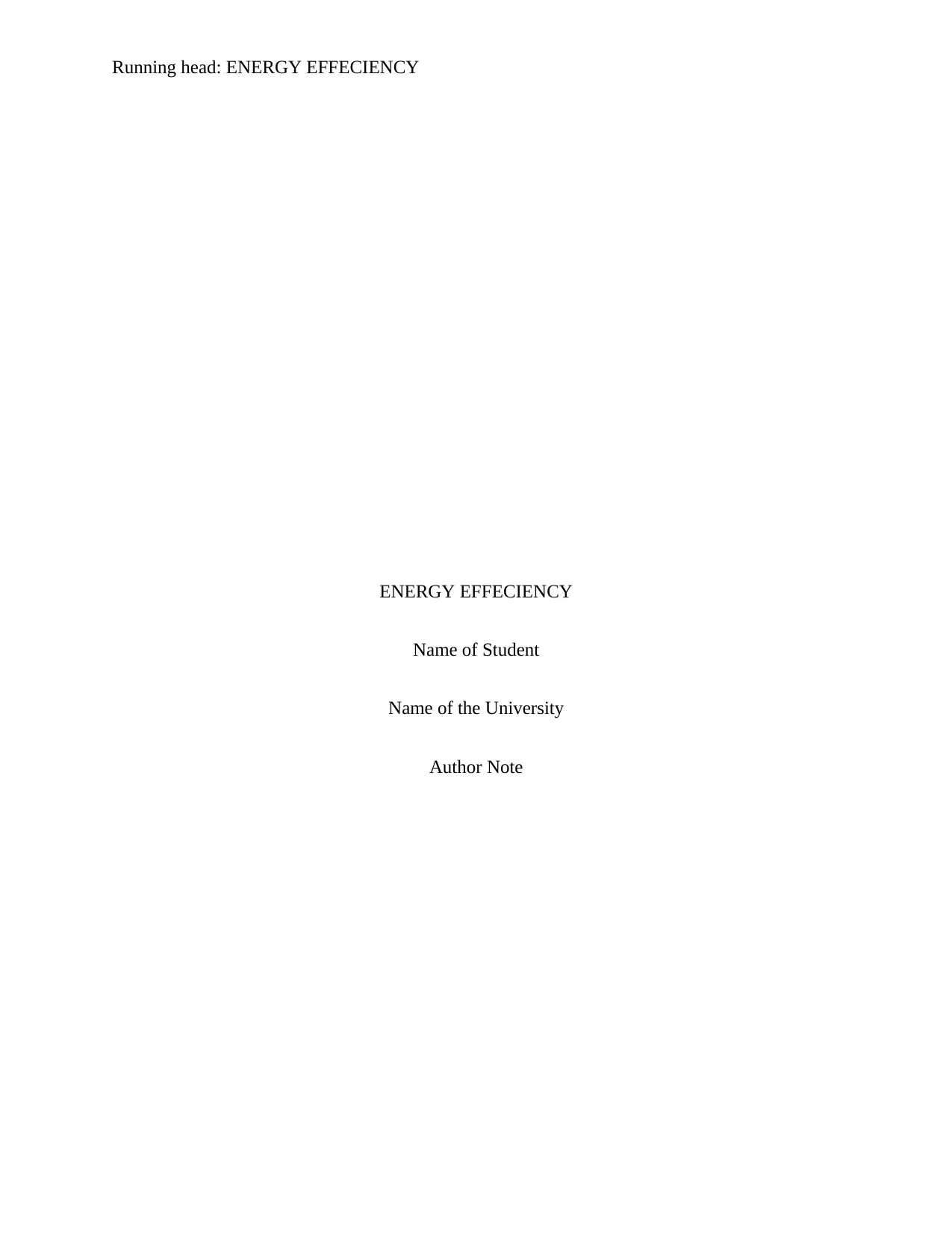
Running head: ENERGY EFFECIENCY
ENERGY EFFECIENCY
Name of Student
Name of the University
Author Note
ENERGY EFFECIENCY
Name of Student
Name of the University
Author Note
Paraphrase This Document
Need a fresh take? Get an instant paraphrase of this document with our AI Paraphraser
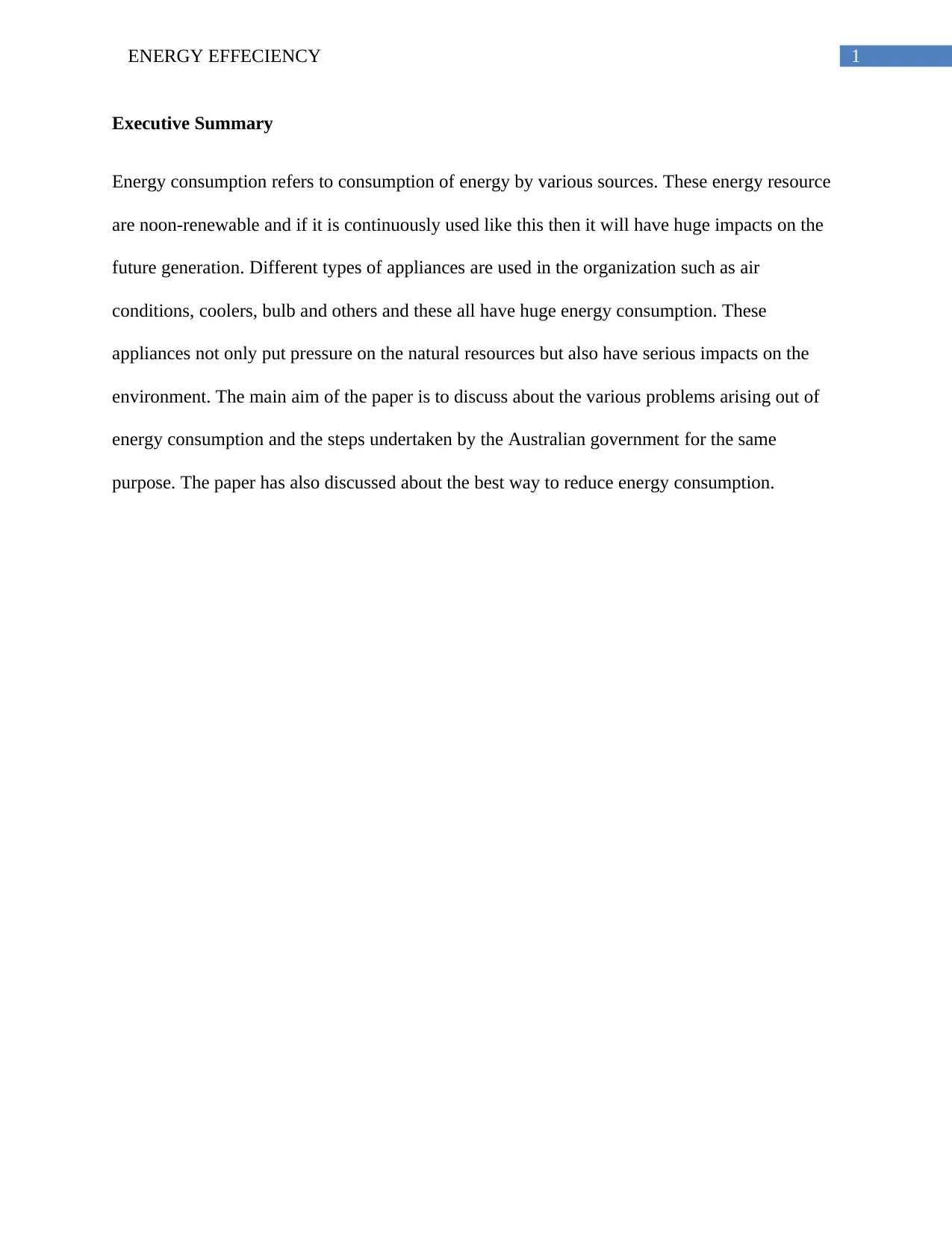
1ENERGY EFFECIENCY
Executive Summary
Energy consumption refers to consumption of energy by various sources. These energy resource
are noon-renewable and if it is continuously used like this then it will have huge impacts on the
future generation. Different types of appliances are used in the organization such as air
conditions, coolers, bulb and others and these all have huge energy consumption. These
appliances not only put pressure on the natural resources but also have serious impacts on the
environment. The main aim of the paper is to discuss about the various problems arising out of
energy consumption and the steps undertaken by the Australian government for the same
purpose. The paper has also discussed about the best way to reduce energy consumption.
Executive Summary
Energy consumption refers to consumption of energy by various sources. These energy resource
are noon-renewable and if it is continuously used like this then it will have huge impacts on the
future generation. Different types of appliances are used in the organization such as air
conditions, coolers, bulb and others and these all have huge energy consumption. These
appliances not only put pressure on the natural resources but also have serious impacts on the
environment. The main aim of the paper is to discuss about the various problems arising out of
energy consumption and the steps undertaken by the Australian government for the same
purpose. The paper has also discussed about the best way to reduce energy consumption.
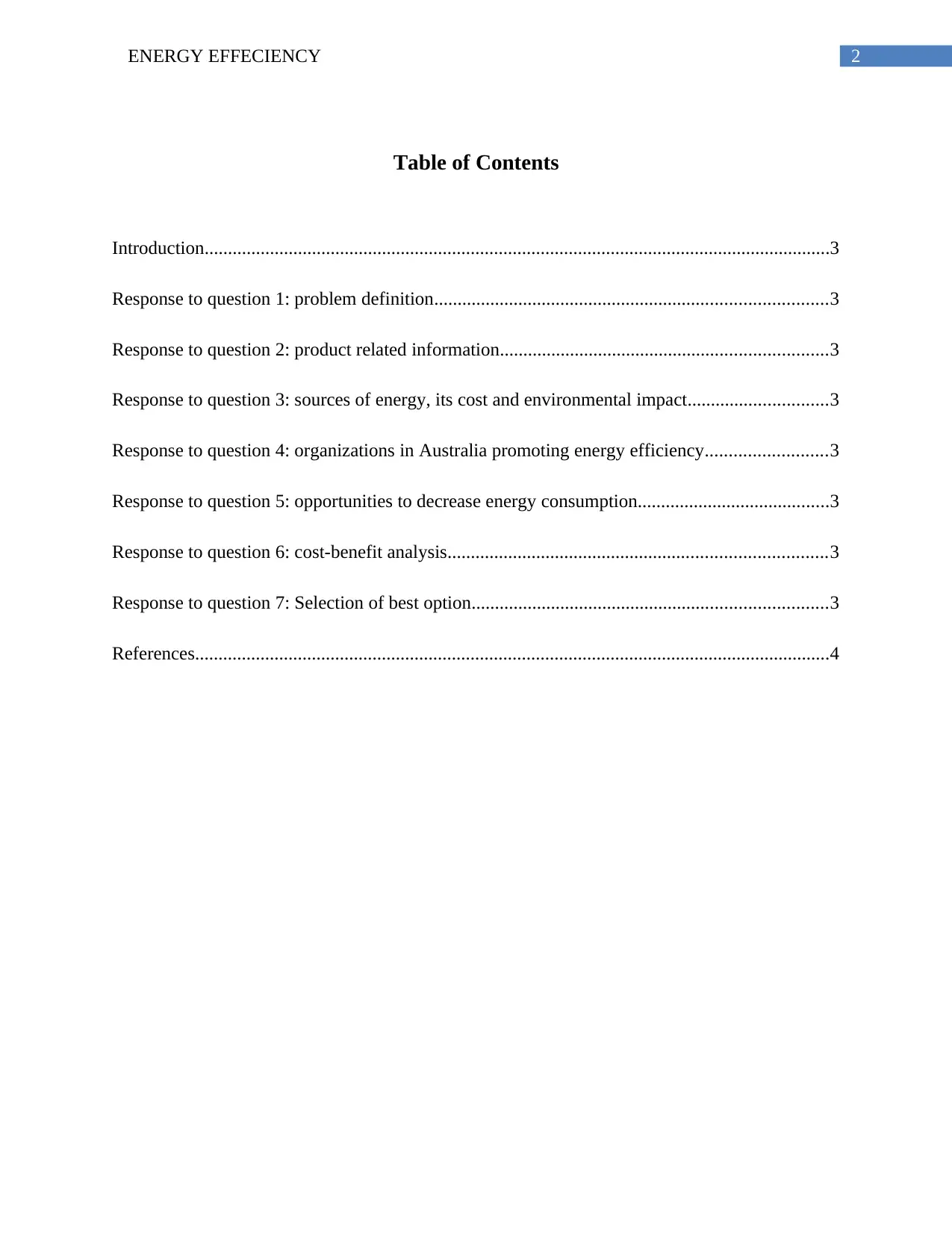
2ENERGY EFFECIENCY
Table of Contents
Introduction......................................................................................................................................3
Response to question 1: problem definition....................................................................................3
Response to question 2: product related information......................................................................3
Response to question 3: sources of energy, its cost and environmental impact..............................3
Response to question 4: organizations in Australia promoting energy efficiency..........................3
Response to question 5: opportunities to decrease energy consumption.........................................3
Response to question 6: cost-benefit analysis.................................................................................3
Response to question 7: Selection of best option............................................................................3
References........................................................................................................................................4
Table of Contents
Introduction......................................................................................................................................3
Response to question 1: problem definition....................................................................................3
Response to question 2: product related information......................................................................3
Response to question 3: sources of energy, its cost and environmental impact..............................3
Response to question 4: organizations in Australia promoting energy efficiency..........................3
Response to question 5: opportunities to decrease energy consumption.........................................3
Response to question 6: cost-benefit analysis.................................................................................3
Response to question 7: Selection of best option............................................................................3
References........................................................................................................................................4
⊘ This is a preview!⊘
Do you want full access?
Subscribe today to unlock all pages.

Trusted by 1+ million students worldwide

3ENERGY EFFECIENCY
Introduction
Energy consumption refers to the amount of energy consumed by the various appliances
and systems (Gillingham, Rapson and Wagner 2016). Energy consumption has become a major
issue in the present day especially consumption of fuel, coal and others due to lack of availability
of natural resources. It has become important to identify alternative sources of energy in order to
reduce the burden on the existing energy resources. The appliance selected for the purpose of this
study is the air conditioner of my workplace (Li et al. 2016). The main aim of the paper is to
discuss about the various problems arising out of energy consumption and the steps undertaken
by the Australian government for the same purpose. There is not only a burden on the existing
natural resources but also has a negative impact on the environment.
Response to question 1: problem definition
The main problem faced due to the energy consumption by the appliances is that natural
resources are getting wasted for this purpose due to the energy consumption by the appliances
(Gerarden, Newell and Stavins 2017). These resources on which energy consumption is
dependent is limited in the nature and if these extinguishes than it will become difficult to carry
out any energy consumption activities in future. Moreover, the usage of air conditioners has a
negative impact on the environment as these appliances release chloro fluoro carbons that affects
the greenhouse gases of the environment and therefore is leading to various other serious
environmental issues.
Introduction
Energy consumption refers to the amount of energy consumed by the various appliances
and systems (Gillingham, Rapson and Wagner 2016). Energy consumption has become a major
issue in the present day especially consumption of fuel, coal and others due to lack of availability
of natural resources. It has become important to identify alternative sources of energy in order to
reduce the burden on the existing energy resources. The appliance selected for the purpose of this
study is the air conditioner of my workplace (Li et al. 2016). The main aim of the paper is to
discuss about the various problems arising out of energy consumption and the steps undertaken
by the Australian government for the same purpose. There is not only a burden on the existing
natural resources but also has a negative impact on the environment.
Response to question 1: problem definition
The main problem faced due to the energy consumption by the appliances is that natural
resources are getting wasted for this purpose due to the energy consumption by the appliances
(Gerarden, Newell and Stavins 2017). These resources on which energy consumption is
dependent is limited in the nature and if these extinguishes than it will become difficult to carry
out any energy consumption activities in future. Moreover, the usage of air conditioners has a
negative impact on the environment as these appliances release chloro fluoro carbons that affects
the greenhouse gases of the environment and therefore is leading to various other serious
environmental issues.
Paraphrase This Document
Need a fresh take? Get an instant paraphrase of this document with our AI Paraphraser

4ENERGY EFFECIENCY
Response to question 2: product related information
The consumption of energy by air conditioners is equal to 3000-5000 power watts is
consumed every hour by using it for nine hours in a day (Davis and Gertler 2015). The energy
efficiency ratio helps in calculating the Air conditioner power that is also known as the cooling
capacity. Depending upon the tons of Air conditioner the energy consumption varies. For a 1 ton
ac the power consumption will be 984watts, for a 1.5 tons ac the energy consumed is 1490 and
others.
Response to question 3: sources of energy, its cost and environmental impact
The sources of energy consumed are the non-durable electrical energy that comprises of
the alternative current. Alterative current is the current that reverses its direction and is used to
supply power. Therefore the air conditioners consume electricity (Ürge-Vorsatz et al. 2015). The
cost of air conditioners ranges from 29,000 dollars to 50000 dollars. The impact of using air
conditioners is that it releases carbon dioxide and consumes too much energy and as a result the
environment is negatively affected. The emissions from the air conditioners have Chlorofloro
carbons that have a negative impact on the environment by release of various pollutants that
causes air pollution and others and is responsible for rising temperatures in the environment.
The New South Wales has an annual emission of greenhouse gases is 146 million tons. The
government of New South Wales is trying to carry out various action plans to save the non-
renewable energy resources.
Response to question 2: product related information
The consumption of energy by air conditioners is equal to 3000-5000 power watts is
consumed every hour by using it for nine hours in a day (Davis and Gertler 2015). The energy
efficiency ratio helps in calculating the Air conditioner power that is also known as the cooling
capacity. Depending upon the tons of Air conditioner the energy consumption varies. For a 1 ton
ac the power consumption will be 984watts, for a 1.5 tons ac the energy consumed is 1490 and
others.
Response to question 3: sources of energy, its cost and environmental impact
The sources of energy consumed are the non-durable electrical energy that comprises of
the alternative current. Alterative current is the current that reverses its direction and is used to
supply power. Therefore the air conditioners consume electricity (Ürge-Vorsatz et al. 2015). The
cost of air conditioners ranges from 29,000 dollars to 50000 dollars. The impact of using air
conditioners is that it releases carbon dioxide and consumes too much energy and as a result the
environment is negatively affected. The emissions from the air conditioners have Chlorofloro
carbons that have a negative impact on the environment by release of various pollutants that
causes air pollution and others and is responsible for rising temperatures in the environment.
The New South Wales has an annual emission of greenhouse gases is 146 million tons. The
government of New South Wales is trying to carry out various action plans to save the non-
renewable energy resources.
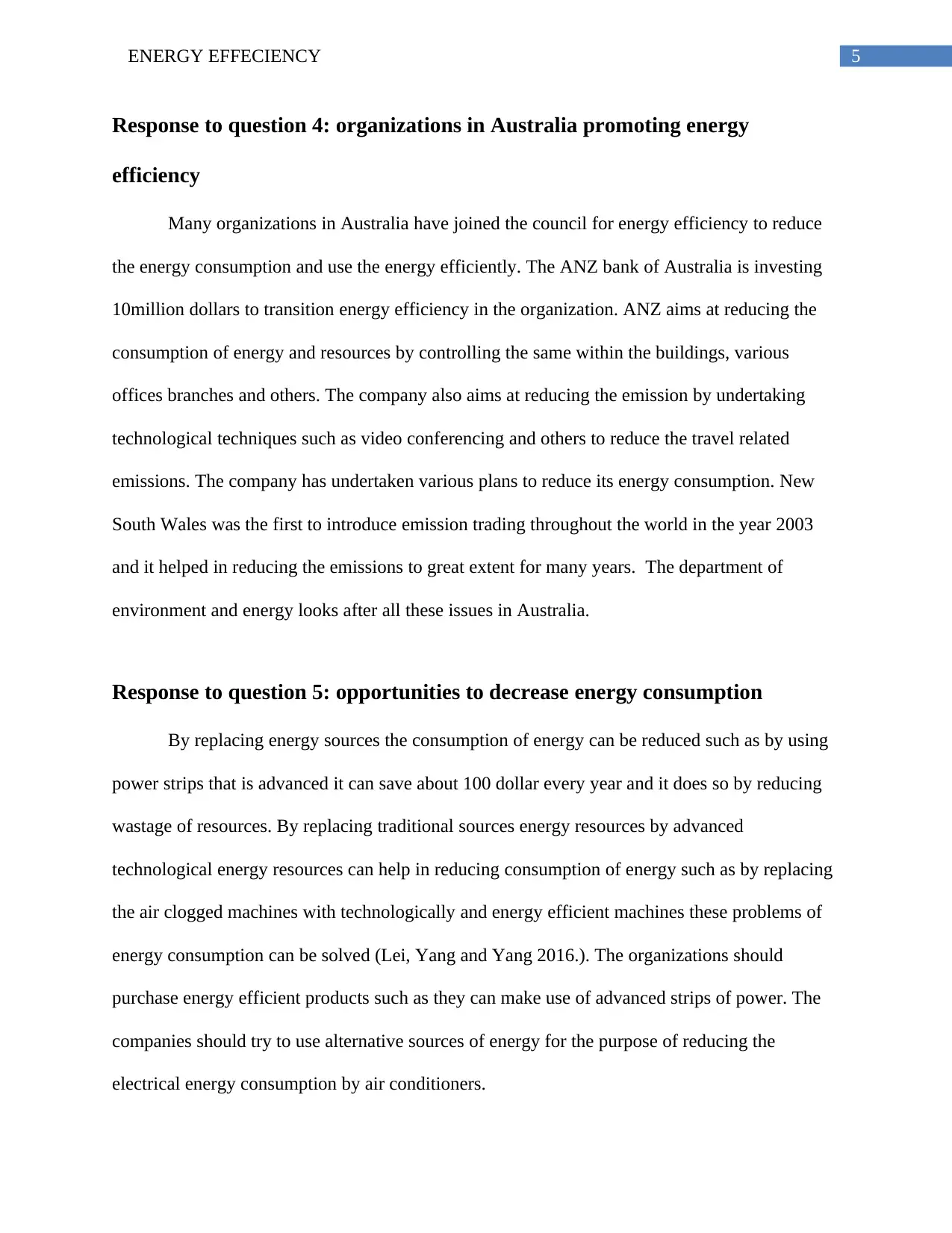
5ENERGY EFFECIENCY
Response to question 4: organizations in Australia promoting energy
efficiency
Many organizations in Australia have joined the council for energy efficiency to reduce
the energy consumption and use the energy efficiently. The ANZ bank of Australia is investing
10million dollars to transition energy efficiency in the organization. ANZ aims at reducing the
consumption of energy and resources by controlling the same within the buildings, various
offices branches and others. The company also aims at reducing the emission by undertaking
technological techniques such as video conferencing and others to reduce the travel related
emissions. The company has undertaken various plans to reduce its energy consumption. New
South Wales was the first to introduce emission trading throughout the world in the year 2003
and it helped in reducing the emissions to great extent for many years. The department of
environment and energy looks after all these issues in Australia.
Response to question 5: opportunities to decrease energy consumption
By replacing energy sources the consumption of energy can be reduced such as by using
power strips that is advanced it can save about 100 dollar every year and it does so by reducing
wastage of resources. By replacing traditional sources energy resources by advanced
technological energy resources can help in reducing consumption of energy such as by replacing
the air clogged machines with technologically and energy efficient machines these problems of
energy consumption can be solved (Lei, Yang and Yang 2016.). The organizations should
purchase energy efficient products such as they can make use of advanced strips of power. The
companies should try to use alternative sources of energy for the purpose of reducing the
electrical energy consumption by air conditioners.
Response to question 4: organizations in Australia promoting energy
efficiency
Many organizations in Australia have joined the council for energy efficiency to reduce
the energy consumption and use the energy efficiently. The ANZ bank of Australia is investing
10million dollars to transition energy efficiency in the organization. ANZ aims at reducing the
consumption of energy and resources by controlling the same within the buildings, various
offices branches and others. The company also aims at reducing the emission by undertaking
technological techniques such as video conferencing and others to reduce the travel related
emissions. The company has undertaken various plans to reduce its energy consumption. New
South Wales was the first to introduce emission trading throughout the world in the year 2003
and it helped in reducing the emissions to great extent for many years. The department of
environment and energy looks after all these issues in Australia.
Response to question 5: opportunities to decrease energy consumption
By replacing energy sources the consumption of energy can be reduced such as by using
power strips that is advanced it can save about 100 dollar every year and it does so by reducing
wastage of resources. By replacing traditional sources energy resources by advanced
technological energy resources can help in reducing consumption of energy such as by replacing
the air clogged machines with technologically and energy efficient machines these problems of
energy consumption can be solved (Lei, Yang and Yang 2016.). The organizations should
purchase energy efficient products such as they can make use of advanced strips of power. The
companies should try to use alternative sources of energy for the purpose of reducing the
electrical energy consumption by air conditioners.
⊘ This is a preview!⊘
Do you want full access?
Subscribe today to unlock all pages.

Trusted by 1+ million students worldwide

6ENERGY EFFECIENCY
Response to question 6: cost-benefit analysis
Cost benefit analysis is the process of identifying alternatives for assessing their strengths
and weaknesses as it helps in analyzing the cost of each of the alterative and their respective
benefit by doing so that alternative can be selected that has the maximum benefits and minimum
costs. The payback period method is used to identify the time period within which the initial
investment can be recovered. Therefore pay-back period helps in taking decisions regarding the
investments. The company will invest in those projects where the pay-back period is shorter. For
instance, the pay-back period in case of buying technologically modified period may be 3-4years
whereas in case of using alternative fuel is 2years then the company will invest in the project
where the pay-back period is shorter.
Response to question 7: Selection of best option
The best way to reduce the energy consumption by air conditioners is to use
environmental friendly and energy efficient air conditioners because they will help to reduce the
negative impacts on the environment (Allouhi et al. 2015). The alternatives available for HFC’s
is the natural refrigerants, lower GWP or global warming potential HFC’s for instance the R32
and various others. Besides this, the stationery air conditioning can be used to comfort the living
and rooms in the workplace. Movable AC’s such that these can be moved by the user and as a
result many ac’s will not be required in the workplace and as a result the energy consumption
will also be less (Jeong and Lee 2015).
Response to question 6: cost-benefit analysis
Cost benefit analysis is the process of identifying alternatives for assessing their strengths
and weaknesses as it helps in analyzing the cost of each of the alterative and their respective
benefit by doing so that alternative can be selected that has the maximum benefits and minimum
costs. The payback period method is used to identify the time period within which the initial
investment can be recovered. Therefore pay-back period helps in taking decisions regarding the
investments. The company will invest in those projects where the pay-back period is shorter. For
instance, the pay-back period in case of buying technologically modified period may be 3-4years
whereas in case of using alternative fuel is 2years then the company will invest in the project
where the pay-back period is shorter.
Response to question 7: Selection of best option
The best way to reduce the energy consumption by air conditioners is to use
environmental friendly and energy efficient air conditioners because they will help to reduce the
negative impacts on the environment (Allouhi et al. 2015). The alternatives available for HFC’s
is the natural refrigerants, lower GWP or global warming potential HFC’s for instance the R32
and various others. Besides this, the stationery air conditioning can be used to comfort the living
and rooms in the workplace. Movable AC’s such that these can be moved by the user and as a
result many ac’s will not be required in the workplace and as a result the energy consumption
will also be less (Jeong and Lee 2015).
Paraphrase This Document
Need a fresh take? Get an instant paraphrase of this document with our AI Paraphraser
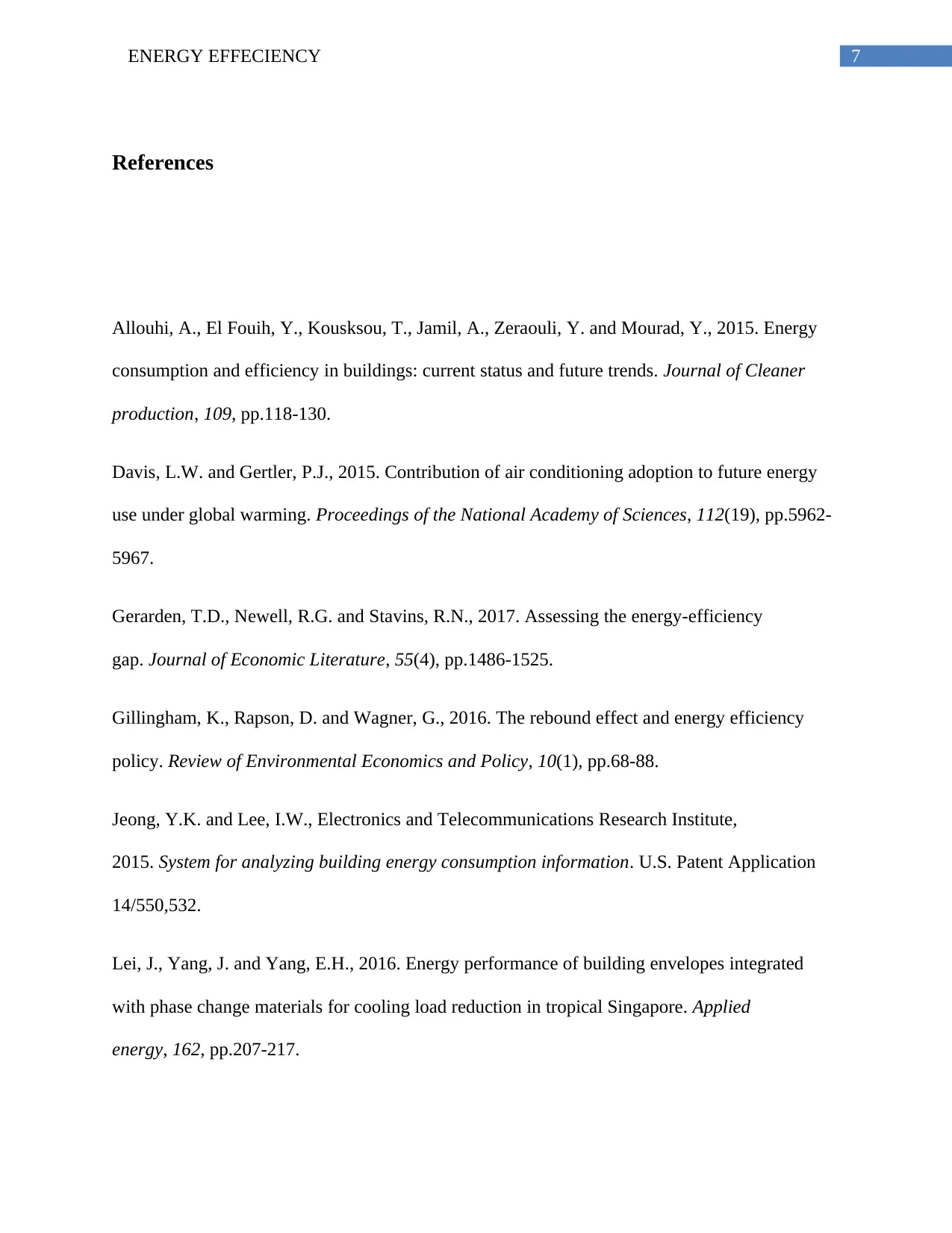
7ENERGY EFFECIENCY
References
Allouhi, A., El Fouih, Y., Kousksou, T., Jamil, A., Zeraouli, Y. and Mourad, Y., 2015. Energy
consumption and efficiency in buildings: current status and future trends. Journal of Cleaner
production, 109, pp.118-130.
Davis, L.W. and Gertler, P.J., 2015. Contribution of air conditioning adoption to future energy
use under global warming. Proceedings of the National Academy of Sciences, 112(19), pp.5962-
5967.
Gerarden, T.D., Newell, R.G. and Stavins, R.N., 2017. Assessing the energy-efficiency
gap. Journal of Economic Literature, 55(4), pp.1486-1525.
Gillingham, K., Rapson, D. and Wagner, G., 2016. The rebound effect and energy efficiency
policy. Review of Environmental Economics and Policy, 10(1), pp.68-88.
Jeong, Y.K. and Lee, I.W., Electronics and Telecommunications Research Institute,
2015. System for analyzing building energy consumption information. U.S. Patent Application
14/550,532.
Lei, J., Yang, J. and Yang, E.H., 2016. Energy performance of building envelopes integrated
with phase change materials for cooling load reduction in tropical Singapore. Applied
energy, 162, pp.207-217.
References
Allouhi, A., El Fouih, Y., Kousksou, T., Jamil, A., Zeraouli, Y. and Mourad, Y., 2015. Energy
consumption and efficiency in buildings: current status and future trends. Journal of Cleaner
production, 109, pp.118-130.
Davis, L.W. and Gertler, P.J., 2015. Contribution of air conditioning adoption to future energy
use under global warming. Proceedings of the National Academy of Sciences, 112(19), pp.5962-
5967.
Gerarden, T.D., Newell, R.G. and Stavins, R.N., 2017. Assessing the energy-efficiency
gap. Journal of Economic Literature, 55(4), pp.1486-1525.
Gillingham, K., Rapson, D. and Wagner, G., 2016. The rebound effect and energy efficiency
policy. Review of Environmental Economics and Policy, 10(1), pp.68-88.
Jeong, Y.K. and Lee, I.W., Electronics and Telecommunications Research Institute,
2015. System for analyzing building energy consumption information. U.S. Patent Application
14/550,532.
Lei, J., Yang, J. and Yang, E.H., 2016. Energy performance of building envelopes integrated
with phase change materials for cooling load reduction in tropical Singapore. Applied
energy, 162, pp.207-217.

8ENERGY EFFECIENCY
Li, S., Ye, L., Zhao, W., Zhang, S., Mukherjee, S., Ade, H. and Hou, J., 2016. Energy‐level
modulation of small‐molecule electron acceptors to achieve over 12% efficiency in polymer
solar cells. Advanced materials, 28(42), pp.9423-9429.
Ürge-Vorsatz, D., Cabeza, L.F., Serrano, S., Barreneche, C. and Petrichenko, K., 2015. Heating
and cooling energy trends and drivers in buildings. Renewable and Sustainable Energy
Reviews, 41, pp.85-98.
Li, S., Ye, L., Zhao, W., Zhang, S., Mukherjee, S., Ade, H. and Hou, J., 2016. Energy‐level
modulation of small‐molecule electron acceptors to achieve over 12% efficiency in polymer
solar cells. Advanced materials, 28(42), pp.9423-9429.
Ürge-Vorsatz, D., Cabeza, L.F., Serrano, S., Barreneche, C. and Petrichenko, K., 2015. Heating
and cooling energy trends and drivers in buildings. Renewable and Sustainable Energy
Reviews, 41, pp.85-98.
⊘ This is a preview!⊘
Do you want full access?
Subscribe today to unlock all pages.

Trusted by 1+ million students worldwide
1 out of 9
Related Documents
Your All-in-One AI-Powered Toolkit for Academic Success.
+13062052269
info@desklib.com
Available 24*7 on WhatsApp / Email
![[object Object]](/_next/static/media/star-bottom.7253800d.svg)
Unlock your academic potential
Copyright © 2020–2025 A2Z Services. All Rights Reserved. Developed and managed by ZUCOL.





